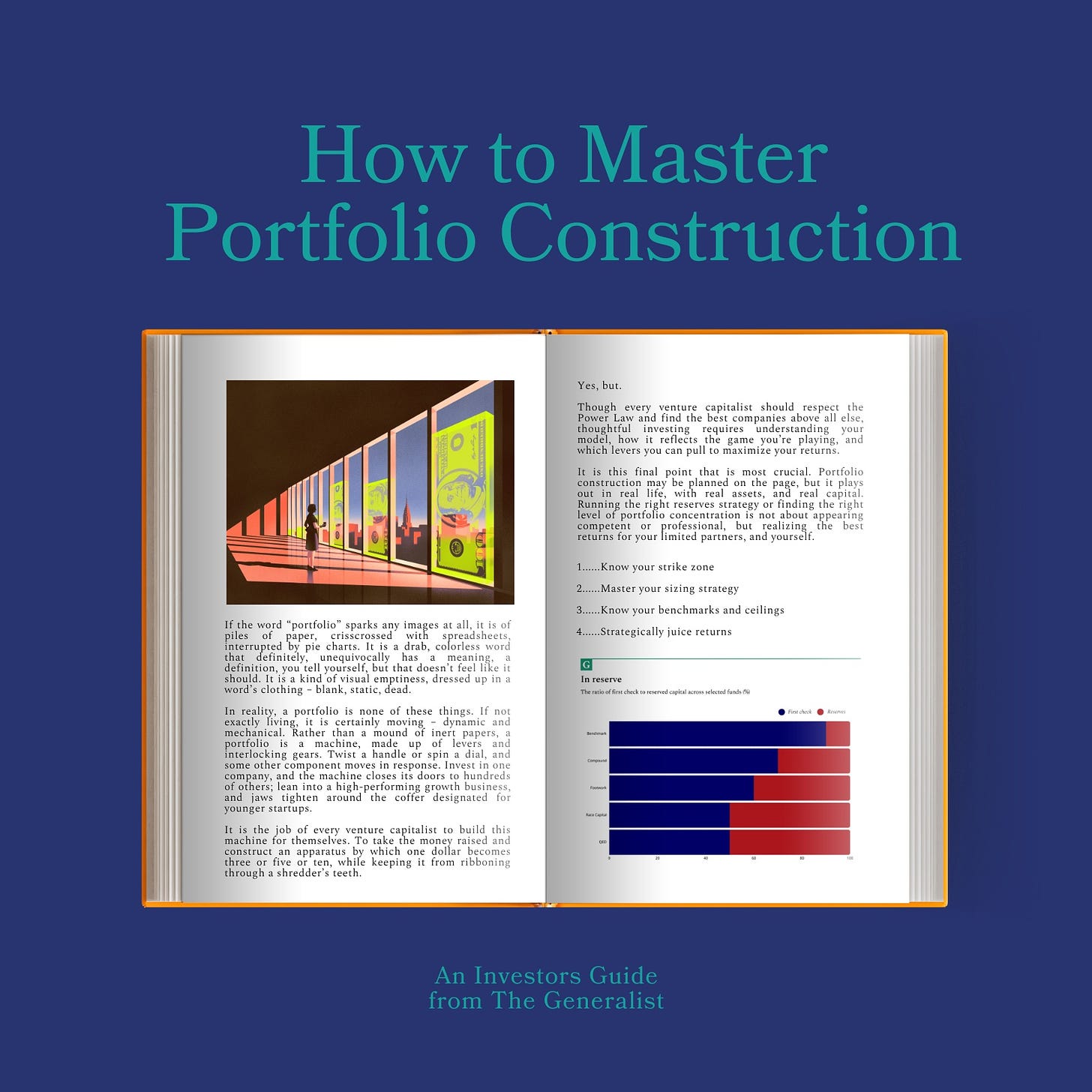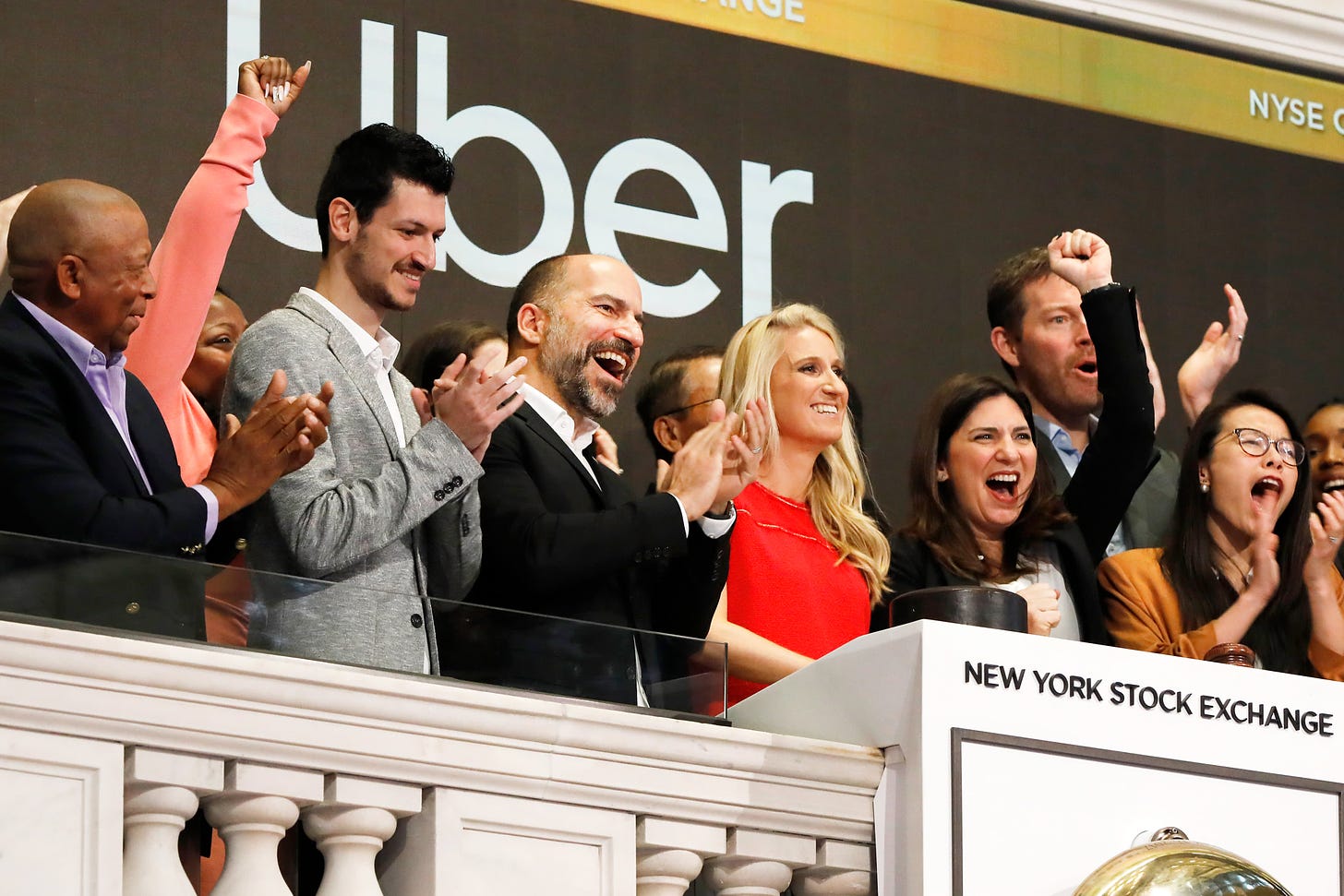🌟 Hey there! This is a subscriber-only edition of our premium newsletter designed to make you a better investor, founder, and technologist. Members get access to the strategies, tactics, and wisdom of exceptional investors and founders. Become a member today.
Friends,
If the word “portfolio” sparks any images at all, it is of piles of paper, crisscrossed with spreadsheets, interrupted by pie charts. It is a drab, colorless word that definitely, unequivocally has a meaning, a definition, you tell yourself, but that doesn’t feel like it should. It is a kind of visual emptiness, dressed up in a word’s clothing – blank, static, dead.
In reality, a portfolio is none of these things. If not exactly living, it is certainly moving – dynamic and mechanical. Rather than a mound of inert papers, a portfolio is a machine made up of levers and interlocking gears. Twist a handle or spin a dial, and some other component moves in response. Invest in one company, and the machine closes its doors to hundreds of others; lean into a high-performing growth business, and jaws tighten around the coffer designated for younger startups.
It is the job of every venture capitalist to build this machine for themselves. To take the money raised and construct an apparatus by which one dollar becomes three or five or ten, while keeping it from ribboning through a shredder’s teeth.
It is a tricky task and one that many novice managers overlook. There are enough venture aphorisms to dissuade the spreadsheet-phobic from ever opening Excel: almost all of your returns will come from one company; do great deals, and the rest takes care of itself.
Yes, but.
Though every venture capitalist should respect the Power Law and find the best companies above all else, thoughtful investing requires understanding your model, how it reflects the game you’re playing, and which levers you can pull to maximize your returns.
It is this final point that is most crucial. Portfolio construction may be planned on the page, but it plays out in real life with real assets and real capital. Running the right reserves strategy or finding the right level of portfolio concentration is not about appearing competent or professional, but realizing the best returns for your limited partners, and yourself.
In today’s edition, we unpack the art and science of portfolio construction with insights gleaned from leading venture capitalists. You’ll learn how the best have designed their funds and the why behind it. You’ll have a clear grasp of the primary tradeoffs and the framework to implement your own approach.
What you’ll get in this guide
A +12,000 word guide detailing the art of portfolio construction, featuring insights and direct quotes from leading venture capitalists.
+25 investors’ insights and strategies on how to put together a fund that maximizes performance.
12 strategies and key factors to consider when constructing your portfolio.
Average portfolio sizes, reserves, and recycling figures from dozens of leading VCs.
Discussions of ownership targets and underwriting practices across funds.
You can unlock all of these benefits and the rest of our premium membership for just $22/month.
Brought to you by Mercury
Paul Graham once referred to Carolynn Levy as “the most influential person in Silicon Valley you’ve never heard of,” and that’s in part because she invented the SAFE (Simple Agreement for Future Equity).
SAFEs allow founders and investors to fast-track the venture capital process — and quickly secure their funding and equity, respectively. Mercury simplifies the process further with a template you can get started with right away.
Ready to invest without additional fees or headaches? Build a SAFE for free on Mercury.
Mastering Portfolio Construction
Deploying capital without a portfolio strategy is like deciding to cross the Sahara Desert without a map. It’s possible you might make it to the other side, to an oasis of lush DPIs and fertile IRRs, but not especially likely.
Felicis
Here’s what I would say: every manager who has aspirations to be great has to have some kind of model or plan for their fund. I’m not sure everybody does – maybe they just have a vague idea. But you have to have a very precise plan, put it on a spreadsheet, and make assumptions around how your investments might turn out based on market comps, certain ownerships, and likely exits. You then have to figure out how that translates into at least a 3x fund, net of fees.
– Aydin Senkut
To avoid languishing in a barren scrubland of 0.5x MOICs and stymied fundraises, you must devise an approach to portfolio construction and understand the different variables at work and how they influence one another. This edition will unpack four key steps, addressing the major considerations and tradeoffs along the way.
Step 1: Know your strike zone
Sector
Geography
Stage
Step 2: Master your sizing strategy
Fund size
Concentration vs. diversification
Ownership
Step 3: Know your benchmarks and ceilings
Company-level
Fund-level
Step 4: Maximizing returns
Managing reserves
Opportunity funds and SPVs
Recycling
Iterate and make exceptions
Thank you to Andrew Steele (Activant), Aydin Senkut (Felicis), Ben Sun (Primary), Brett Berson (First Round), Chris McCann (Race), Firat Ileri (Hummingbird), Frank Rotman (QED), Jesse Walden (Variant Fund), Josh Coyne (Kleiner Perkins), Kanyi Maqubela (Kindred), Lauren Kolodny (Acrew), Michael Dempsey (Compound), Mike Duboe (Greylock), Nikhil Basu-Trivedi (Footwork), Niki Scevak (Blackbird), Rebecca Kaden (USV), Rex Woodbury (Daybreak), Saam Motamedi (Greylock), Saar Gur (CRV), Sajith Pai (Blume), Sarah Guo (Conviction), Sarah Tavel (Benchmark), Scott Sobel (Valor), Terrence Rohan (Otherwise), and Tomasz Tunguz (Theory) for sharing their insights for this issue of the Investors Guide series.
Step 1: Know your strike zone
More than any other sport, venture capital is compared to baseball. Because of the risk inherent in the asset class, it is an industry built for “sluggers,” investors aiming for home-run outcomes rather than doubles or triples.
This is, of course, because of the Power Law – the mathematical reality that a tiny number of investments deliver the majority of returns. Examples of the Power Law at play are the lore on which great venture firms are built. For example, Benchmark turned a $12 million investment in Uber into a $7 billion return. When cryptocurrency exchange Coinbase went public in 2021, Andreessen Horowitz’s stake was worth $10 billion, more than half the capital the firm had raised from investors over its entire lifespan.
The Power Law is a truth well acknowledged by the investors we interviewed:
Valor Capital Group
If you look at the best-performing VCs, the performance comes from a small number of companies.
– Scott Sobel
Conviction
The really great companies provide most of the returns.
– Sarah Guo
To be capable of hitting a ball that sails beyond an outfielder’s reach and into the stands, investors must first know their “strike zone” – the area in which they choose to take a swing and make an investment. Do you plan to invest in logistics startups at the seed or health-tech businesses at the Series B? Will you concentrate on the New York City ecosystem or the fintech explosion emanating from Latin America? How, exactly, across sector, geography, and stage will you allocate the funds with which you’ve been entrusted?
Sector
The sectors you choose to invest in impact how you build your portfolio. For example, an AI fund and a specialist logistics firm should have distinct approaches that reflect the differing realities of each field. AI is currently a hyper-competitive industry, leading to large rounds and high valuations. Many of the most popular businesses in the space are capital-intensive and are raising at a rapid clip. It’s a transformative technology that optimists believe could result in extremely large outcomes. Meanwhile, the logistics industry is not in the midst of an investor frenzy. It remains an enormous, high-impact industry with a customer base that is often slow to embrace new technologies.
Aydin Senkut, founder of Felicis, explained how his underwriting changes depending on the sector:
Felicis
Let’s use real examples. Over the last 18 months, we’ve been seeing some great companies in biotech and there’s not enough demand. It’s reasonably straightforward for a fund like ours to do 10% ownership seed deals at great valuations.
The way we think about it is that biotech multiples are lower, but there are a lot more exits in this environment. If you can pick something important, like next-generation cancer therapy, that's a valuable area. There’s execution risk, but when you’re getting great ownership and a great valuation, it’s worth taking a chance.
On the other hand, AI and security are some of the hottest areas right now. We’re not doing every AI or security deal, but what we’re seeing is that these companies are getting the highest multiples right now. Outside of biotech, they’re also the ones where the most exits are happening – the highest multiples and the highest exits.
When you look at the established companies in the security space, firms like Palo Alto Networks, Zscaler, and Crowdstrike – these are $50 billion-plus companies. When you look at markets, you have to instrument and quantify it. It’s possible that a startup grows bigger than the public comps, but at least look at them as the floor or anchor within a given market. If you have multiple $50 billion companies in a space, it’s more realistic to say you’re going to catch one of them.
When we’re trying to get into a company, and that’s the floor, we can be more aggressive. But if it’s in biotech where multiples are lower, and exit prices are lower, then you have to have higher ownership at a lower valuation to make it work.
– Aydin Senkut






